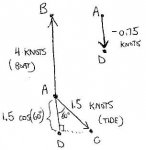Can you help please. I am trying to construct a trig formula to solve this problem:
I am sailing a straight line (side c) to get to my destination which is 5.42 nautical miles away. My boat speed is 3 knots. The tide is flowing at 2.5 knots (side a) at an angle of 3 degrees (Angle B). I need to know how long this will take or in other words the length of side b of the triangle. I know that the figures I am using mean that it is possible to say that it will take a little less than an hour but I am looking for a formula that will work with variations of data - for example if Angle B was 120 degrees.
Is this possible please?
I am sailing a straight line (side c) to get to my destination which is 5.42 nautical miles away. My boat speed is 3 knots. The tide is flowing at 2.5 knots (side a) at an angle of 3 degrees (Angle B). I need to know how long this will take or in other words the length of side b of the triangle. I know that the figures I am using mean that it is possible to say that it will take a little less than an hour but I am looking for a formula that will work with variations of data - for example if Angle B was 120 degrees.
Is this possible please?

